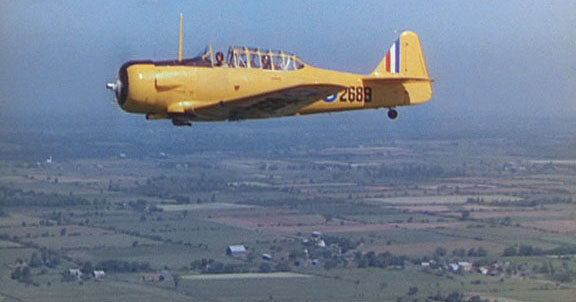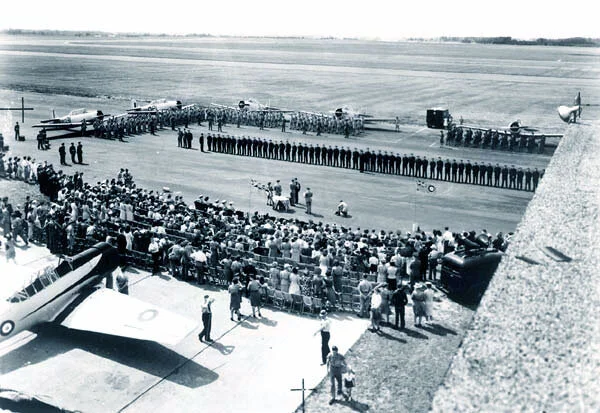INSIDE UPLANDS
During the long days of the Second World War, the wide, flat Ottawa Valley was a virtual production line for pilots bound for the battlefront theatres of Europe, North Africa, Asia and South Pacific. Young, eager men from distant lands and from the far corners of Canada would arrive by steam train at Ottawa's magnificent Union Station. Men, clothed in the blue great coats of the Royal air forces, leaned from the platforms and windows of incoming coaches making their way that last slow mile along the frozen Rideau Canal, peering at the gothic towers of Canada's Parliament Buildings, framed by a vast cumulus of steam rising from Hull's pulp and paper mills. The air was icy. The sky hard blue. The sons of New Zealand sheep farmers and cattlemen of Queensland, or the college students of California must have wondered just what frozen hell they were entering.
Soon, from the air, they would come to know this ancient valley very well. From Union Station they would find their way to flight schools and RCAF stations scattered across its flat plain - No. 10 EFTS Pendleton, No. 13 EFTS St. Eugene, No. 3 Flying Instructors School, Arnprior, RCAF Station Rockcliffe, the relief landing fields of Killaloe, Carp, Hawkesbury and others. But at the centre of it all was the massive No.2 Service Flying Training School at Uplands south of Ottawa - the present day home of Ottawa's Macdonald-Cartier International Airport.
Here, thousands of young men would complete their Service Flying Training on North American Harvards and Yales, after which they dispersed for further training, instructor school and for most the little understood risks of all out war in Europe and the Pacific. Ottawa would become a stepping off point where they would hone their nascent skills, build hours flying day and night. The risks of the war that was out over the horizon were great indeed, but training in itself was extremely dangerous and demanding. The sky above the Ottawa Valley, from Arnprior to Lac des Deux Montagnes, was a crowded place indeed. From sun-up to sundown, and to a lesser extent throughout the nights, Harvards, Yales, Tiger Moths, Cornels and Finches speckled the sky. Cross-country flights droned, formation practices thundered, aerobatics looped and spun and rolled in a crazy cacophony right down the whole valley. It was not a good time and place to be a mink farmer or to search for a quiet, meditative spot. There was a war on and the complainers were few.
All these aircraft required constant attention from mechanics and ground crews. As a result, bases like No. 2 SFTS Uplands had huge populations, not only of student and instructor pilots, but of service people, mechanics and administration staff. Over the past couple of years, whilst researching other stories, we have come across a number of photographs of operations in and around No. 2 SFTS. When viewed all together they begin to paint a picture of a day in the life of this long gone place in Canadian history.
Recently I was contacted by David Russell who shared with me a suite of photographs of day-to-day life at Uplands. With the images coming to light thanks to Russell, Vintage Wings has put together these and other images of No.2 SFTS so that you can perhaps see back over the decades and have a clearer picture of what this important facility in our community looked like. Let's go back nearly 70 years and take a look at a day in the life of Number Two Service Flying Training School, Uplands.
The vast open space of a maintenance hangar at No. 2 SFTS. With the doors open and surrounded by windows, there was a tremendous amount of natural light, allowing the DND photographer to capture details a couple of hundred feet away. Photo via David Russell
Mechanics are hard at work on the Pratt and Whitney engine of one of the Uplands Harvards. Given the number of mechanics surrounding the engine, it seems a bit staged, but perhaps there was a bit of consultation going on, or perhaps training. Photo via David Russell
Backing off from the same scene as above, we see the massive central steel beam of the hangar design - allowing vast clear spaces beneath. To the right stands the two story tool crib where tools were signed out. In the foreground we see Harvard 3197, which may have been from RCAF Station Rockcliffe across town. According to R.W.R. Walker's spectacular Canadian Military Aircraft Serial Numbers database, 3197 suffered Category B damage on 16 September 1941 while with No. 14 Service Flying Training School at RCAF Station Aylmer, Ontario. It was also with Air Force Headquarters Practice flight at RCAF Station Rockcliffe, Ontario. Photo via David Russell
Related Stories
Click on image
Mechanics line up to sign out tools from the central tool crib - a building within a building. Photo via David Russell
We're not sure but possibly this was a staged shot of a woman spraying paint on the engine cowling of Harvard. There is no indication of masking off or even cleaning of the cowling. The lack of face mask and even the proximity of paperwork seem slightly haphazard. Photo via David Russell
A place for everything and everything in its place - the tool crib inside a hangar at No. 2 SFTS Uplands. Photo via David Russell
The vast space enclosed within a full-sized BCATP maintenance hangar is very impressive indeed. Photo via David Russell
A little bit of mechanic humour - this thermometer indicates the level of aircraft serviceability- when the mechanics have reached 90% serviceable aircraft, there is a "Sports Parade" and only when aircraft serviceability exceeds 100% do they receive an "Afternoon Off". Photo via David Russell
The Aircraft Records Carousel - records keepers sat at three chairs within this circle of files and signed them out or perhaps entered the work done when it was reported by crew chiefs. In the background stands a chalkboard with updated information about the current status of each aircraft going through maintenance - a clear indication of the complexities of running a training facility with more than 100 aircraft on site. Reading the dates on the chalkboard with a magnifying glass puts this photo in March and April of 1941 - at the same time as the poet laureat of flight John Gillespie Magee. Photo via David Russell
The Senior NCO's mess at Uplands around 1941-42. The men shown are either Sergeants, Flight Sergeants or Warrant Officers. It is probably the noon meal. David Russell's father is in the foreground on the left. He was a W/O at the time. Everyone in this photo looks happy including the waitresses who, judging by the ties underneath their smocks, are air force personnel. Photo via David Russell.
Not unlike an assembly line, there was great pressure to keep up - overhead next to the tool crib was a large clock face with very visible hands to let mechanics know when they should be finished their respective tasks. Photo via David Russelll
Instructor and student review the lessons of the day's flight on a sunny July day in 1941 out on the Uplands flightline. Photograph by Nicholas Morant, National Film Board of Canada
The flight line at No.2 SFTS Uplands - a busy place indeed. The Harvard at the very centre of this photo with the bright roundel and pilots on the wing is Harvard 3042, one of 12 different Harvards that were recorded in the log book of John Gillespie Magee, the poet who wrote High Flight. Another, 2866, was selected as the High Flight Harvard - Vintage Wings of Canada's flying tribute to No. 2 SFTS Uplands. Photo: DND, via Bryan Nelson, CAPA
Another shot of the Uplands flight line in 1941 - this a screen capture from the movie Captains of the Clouds. Harvard 2588 continued on in the service of the RCAF until 1952, operating from No. 13 SFTS St Hubert, Quebec, No. 14 SFTS Portage LaPrairie and finally Gimli, Manitoba. Image via Warner Bros.
A Harvard with an "erk" (maintainer) walking the wing rolls down the flightline at No. 2 SFTS Uplands. Photo from website dedicated to the memory of Flying Officer Pierre Risso Carpenter
The ship that launched a thousand tributes. Harvard 2866, known to have been flown by John Gillespie Magee, thunders down the Ottawa River, where this past weekend (September 19th 2009) an identically marked one known as the High Flight Harvard flew for thousands at the Vintage Wings of Canada Open House. This exceptional side-on image allowed us to make accurate measurements for the remarking of our Harvard. Photo via Benno Goethals
Harvard 2697 overflies the maintenance hangars at No. 2 SFTS - the hangar featured in this article is most likely one of these. Possibly taken at a wings parade as the aircraft (Harvards, Hudsons and others) are parked in precise order around and between the hangars. Photo: Australian War Memorial
Once the aircraft were repaired, a test flight was in order. Here, in September of 1941, Leading Aircraftman John Douglas of the Royal Australian Air Force is seen testing a Harvard 9,000 feet above Uplands. He was later killed in 1945 near Munster, Germany whilst attacking the Dortmund Ems Canal. Photo: The Australian War Museum
Instructors and students of No. 2 SFTS practice formation flying over farm land near RCAF Station Uplands in July of 1941. Most of the photographs of No. 2 operations found across the net or sent to me by people like David Russell date from the spring and summer of 1941. Perhaps it was the attention brought to Uplands by the filming of Captains of the Clouds, shot on location at No. 2 SFTS in the late spring and summer of that year, that drew photographers from around the world. Photo by Nicholas Morant. Department of National Defence / National Archives of Canada, PA-140659
Not every training flight ended in a successful landing back at No. 2 SFTS. Every once in a while there would be a little road trip to retrieve lost property of the RCAF. Here David Russell's father Warrant Officer A.G. Russell (foreground) inspects damage and oversees the recovery of Harvard 2689 based at No.2 SFTS Uplands which made a forced landing in the snow at Navan, just east of Ottawa.
From belly landing to movie star. The same Harvard (2689) as seen ignominiously in the snow at Navan in the photo above, now flies a few months later in the Warner Bros. classic film Captains of the Clouds. According to Rudy Mauro (perhaps the most knowledgeable person on the filming of this movie) Harvard 2689 was sent to Noorduyn for refurbishing and arrived back at Uplands freshly painted just before the filming for the movie started. The fresh paint is probably the reason it was selected for some of the technicolour shots in the movie. Photo: Warner Bros
The now-famous image of the filming of Warner Bros' Captains of the Clouds, starring James Cagney - filmed on location at Trenton, North Bay and No.2 Service Flying Training School Uplands in Ottawa. Here they are filming famous Canadian First World War ace Billy Bishop reviewing graduates of the school and giving them their wings. Photo DND
An Uplands wings parade in 1943 shows us that this important day in a pilot's career were grand events, even when a Hollywood film crew was not in attendance. Photo: National Archives of Canada, PA-125993
For his technical service during the filming of Captains of the Clouds, Flight Sergeant Andrew Russell received this director's chair with his name on the back and Captains of the Clouds on the front. It still resides with his son David.






























